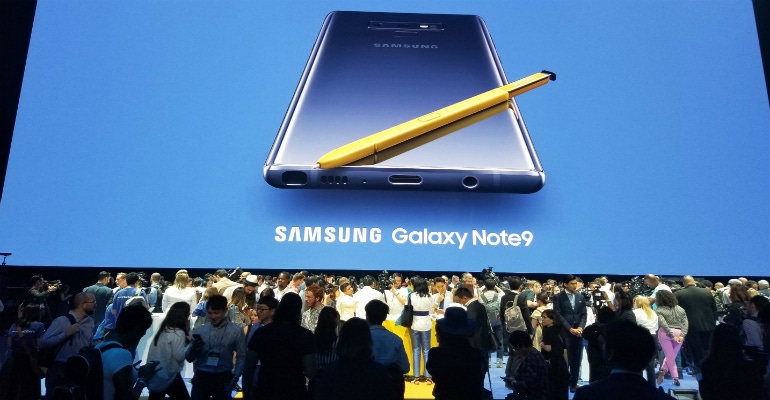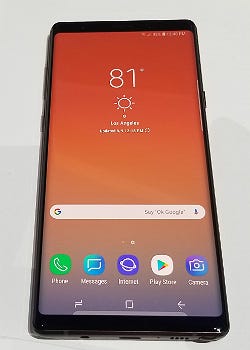Samsung launches the new Galaxy Note9 with highest levels of capacity and features to date in its premium business-grade smartphone and also introduces the new LTE-capable Galaxy Watch and other new mobility solutions at its Unpacked 2018 event.
August 10, 2018

(Pictured above: Samsung’s Galaxy Note9 launch event in Brooklyn, New York, Aug. 9, 2018.)
SAMSUNG GALAXY UNPACKED — Samsung has fleshed out its mobile portfolio, topped by the launch of the Galaxy Note9, the company’s new high-end mobile phone. The Note9, with a slightly larger OLED display than the current version, is Samsung’s largest, most powerful and highest-capacity smartphone. It will offer partners new hardware and software capabilities suited for the latest cloud-native digital solutions.
The debut of the Note9 was the focus of Thursday’s Samsung’s Galaxy Unpacked 2018 event, held at the Barclay’s sports arena and concert hall in Brooklyn, New York. But Samsung also unexpectedly introduced a new Galaxy Watch, which is compatible with its phones or can work independently as a standalone communications device using built-in LTE connectivity.
Samsung also previewed a new smart speaker powered by Samsung’s Bixby artificial-intelligence platform that will compete with Amazon’s popular Alexa and Google Home. And the company showcased the new S4 Galaxy Tab, its 10.5-inch tablet – quietly introduced last week – that shares many of the features introduced with the new Galaxy Note9.
The launch gives Samsung “a better-connected story” said Bob O’Donnell, chief analyst with Technalysis. Samsung’s latest, twice-yearly “Unpacked” rollout promises to bolster the company’s efforts to expand its new Mobility Solution Partner Program (MSPP), a program kicked off last year to grow its entire family of mobile products to businesses by enabling partners to deliver new horizontal and vertical solutions.
Samsung’s new Note9 has a 6.4-inch display, which is one-tenth of an inch larger than last year’s Note8. The Note9, powered by the release of Android, Oreo 8.1, has a more powerful 10 nanometer, 64-bit Octa-core processor, which is designed to support network speeds of up to 1.2 gigabits per second. The new device has pushed the threshold on phones with its minimum 128 GB capacity (up from 64 GB) and a separate SKU with 512 GB embedded memory. A forthcoming 512 GB microSD card from Samsung will enable the 1 TB capacity.
The Note9 also includes an embedded algorithm to enable AI, and an upgraded 4,000mAh battery, which the company claims will last 21 percent longer than the 3,300nAh in the Note8. The company has also added new cooling capabilities, which Samsung claims will enable the device’s battery to work all day under normal usage.
“It’s not just any smartphone; it’s a phone that raises the bar for speed, power and performance,” said DJ Koh, president and CEO of Samsung’s IT and mobile communications division, in remarks as he introduced the new Note9.

Samsung Galaxy Note 9
Samsung Galaxy Note 9
Set to ship on Aug. 20, Samsung is now priming its partners on some of the new features that will appeal to business users. In an interview with Channel Futures at the launch event, Michael Coleman, Samsung VP of mobile channel sales, said the collective rollout of the Note9, the Galaxy S4 Tab tablet and watch will boost its portfolio of solutions that can be tailored for modern use cases.
Coleman said the portfolio will give further appeal to the new MSPP program, launched last year after the mobile practice was split from the IT products group that provides SSD cards, displays and memory, among other things. Samsung has brought into MSPP both existing solution providers that have mobility practices and those looking to add mobility specialties.
Among the many benefits of Samsung’s go-to-market channel efforts is the fact that its devices are unlocked, allowing partners and customers to make carrier decisions — or even go with multiple wireless providers.
“That’s a huge differentiator because customers want to have choice and negotiating leverage, and with an unlocked phone they can actually have that,” Coleman said. “They buy the phone and they can negotiate the voice and data, independent of the phone that’s already locked in.”
Coleman said Samsung is already more than halfway beyond its goal for this year, but is still looking to bring more partners into MSPP. Those in the program who commit to training and revenue goals are offered MDF, access to events, demand-generation tools, and help with bundling the new offerings for various solution scenarios.
“If you take the new Note9 and we pair that with the [Galaxy] Tab S4 and the watch, we are creating an ecosystem of solutions that business needs,” Coleman said.
Among the key features that will embolden Samsung with its partners include the new S Pen, an embedded DeX and improvements to the Bixby AI algorithm, according to Coleman.
The S Pen, one of the longtime centerpieces of the Note line, is an electronic pen that allows people to take notes and create elaborate illustrations. While each Note upgrade has included enhancements to the S Pen, such as improved pressure sensitivity and higher levels of precision, the latest iteration could be Samsung’s most advanced yet, thanks to its embedded Bluetooth Low Energy (BLE) support, which allows users to control the device remotely to take pictures or display presentations, among other capabilities.
Samsung said the company plans to release an SDK designed to enable ecosystem partners to create new third-party apps that use the S Pen as a controller. Coleman is hopeful that releasing the SDK will spawn new digital solutions from the partner community.
“It allows partners to actually develop applications that make use of the S Pen,” Coleman said. “We have no idea what that will lead to, but it is that ecosystem that we will rely on to create these new things,” he said.
Meanwhile, the Note9’s embedded DeX eliminates the need for the dock, enabling connectivity to a large display with a USB-C to HDMI dongle. The DeX effectively enables people to use the phone as a computer — in addition to a monitor, it also supports a keyboard and mouse.
“We think that’s a real differentiator,” Coleman said. “It changes what a business user can do with the phone.”
The upgrades notwithstanding, the growth rates for phones have tapered in recent years. Analyst Patrick Moorhead, president of Moor Insights and Technology, pointed to Samsung’s Galaxy S9, launched back in the spring.
“The S9 hasn’t sold as well as Samsung would have liked,” Moorhead said. “The Note9 will help its cause as it better competes with the iPhone X and the Huawei P20 Pro.”
O’Donnell said the new features bring more functionality to the phone but described it “as a modest upgrade.”
Smartphone growth has slowed, he added.
“The market has peaked,” he said. “Everyone is holding on to phones longer, it’s much harder to differentiate.”
Nevertheless, the Note9 will appeal to those who prefer using their phones over their computers, said Avi Greengart, research director for platform devices a GlobalData.
“If you are looking for a high-end, productivity-oriented Android phone, with a very large battery, the Note9 is your ticket,” Greengart said.
The cost of that ticket begins at $1,000 for the 128 GB version and $1,249 for the 512 GB unit.
About the Author(s)
You May Also Like


